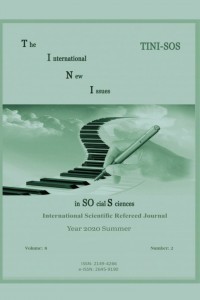Tüketici Algısı ve Tüketici Satın alma Davranışı İlişkisi: Libya Tüketicilerinin Satın alma Davranışı Üzerine Bir Çalışma
Tüketici satın alma davranışı, tüketici algısı
The Relationship Between Consumer Perception and Consumer Buying Behavior: A Case Study of Libyan Consumer Buying Behavior
Consumer buying behavior, consumer perception,
___
- Bashir, Aneeza, And Najma I Malik. (2009). “Effects of Advertisement on Consumer Behavior of University Students”, In Proceedings. Vol. 2. Batra, R, J G Myers, And D. A. Aaker. (1995). “Group Influence and Word-of-Mouth Advertising”, Advertising Management, 345–63. Ganeshasundaram, Raguragavan, And Nadine Henley. (2009). “Reality Television (Supernanny): A Social Marketing ‘Place’ Strategy”, Journal of Consumer Marketing 26 (5). Emerald Group Publishing Limited:311–19. Ghafoor, Abdul, Awan Dean, And Muhammad Ismail. (2016). “Effects of Advertisement on Consumer’s Buying Behaviour With References To Fmcgs In Southern Punjab-Pakistan”, Journal of Marketing and Consumer Research Journal 19, 22–30. Guthrie, Michelle, Hye-Shin Kim, And Jaehee Jung. (2008). “The Effects of Facial Image And Cosmetic Usage on Perceptions of Brand Personality”, Journal of Fashion Marketing and Management: An International Journal 12 (2). Emerald Group Publishing Limited:164–81. Küçük, Orhan. (2016) Bilimsel Araştırma Yöntemleri, Ekin Yayınları, Bursa. Küçük, Orhan, (2016) Perakende Pazarlama Yöntemi, Sonçağ Yayın, Ankara. Küçük Orhan, (2002) “Tüketici Satınalma Davranışında Ambalajın Rolü: Bayburt Meslek Yüksekokulu’nda Bir Uygulama”, Pazarlama Dünyası, Yıl: 16, Sayı: 2002-2, ss. 24-31. Kumar Bishnoi, Vinod, And Ruchi Sharma. (2009). “The Impact of TV Advertising on Buying Behaviour: A Comparative Study of Urban and Rural Teenagers.” Jk Journal of Management & Technology Issn 1 (1):975–924. Http://Www.Ripublication.Com/Jkjmt.Htm. Lafferty, Barbara A, Ronald E Goldsmith, And Stephen J. Newell. (2002). “The Dual Credibility Model: The Influence of Corporate and Endorser Credibility on Attitudes And Purchase Intentions”, Journal of Marketing Theory and Practice 10 (3). Taylor & Francis:1–11. Mccarthy, Edmund Jerome, and William D Perreault. (2000). Applications In Basic Marketing. Irwin.
- Mcguire, William J, R E Rice, And C K Atkin. (2001). “Input and Output Variables Currently Promising For Constructing Persuasive Communications”, Public Communication Campaigns 3, 22–48. Mcwilliams, Edward G, And John L Crompton. (1997). “An Expanded Framework For Measuring The Effectiveness of Destination Advertising”, Tourism Management 18 (3). Elsevier, 127–37. Nylen, David W. (1986). Advertising: Planning, Implementation & Control. Thomson South-Western. Patsioura, Fotini, Maro Vlachopoulou, And Vicky Manthou. (2009). “A New Advertising Effectiveness Model for Corporate Advertising Web Sites: A Relationship Marketing Approach”, Benchmarking: An International Journal 16 (3). Emerald Group Publishing Limited, 372–86. Peter, J Paul, Jerry C. Olson, And Klaus G. Grunert. (1999). Consumer Behaviour and Marketing Strategy. Mcgraw-Hill London. Priya, Pankaj, Rajat Kanti Baisya, and Seema Sharma. (2010). “Television Advertisements And Children’s Buying Behaviour”, Marketing Intelligence & Planning 28 (2). Emerald Group Publishing. Rai, Naveen. (2013). “Impact of Advertising on Consumer Behaviour and Attitude With Reference to Consumer Durables.” International Journal of Management Research And Business Strategy 2 (2):74–79. Rehman, Fazal Ur, Tariq Nawaz, Aminullah Khan, And Shabir Hyder. (2014). “How Advertising Affects The Buying Behavior of Consumers In Rural Areas: A Case of Pakistan”, Academic Research International 5 (4):405–12. Www.Savap.Org.Pk%5cnwww.Journals.Savap.Org.Pk. Tubio, Earl Michael A, Jeanne B Altaque, Katrina V. Lucero, Rudynna Grace C Tagam, Li Fini Rae E Toling, Mary Grace C Veri, and Ray Butch Mahinay. (2016). “Consumer Perception and Purchase Behavior on Online Shopping Among Students In Mindanao University of Science and Technology.” Vaughn, Richard. (1986). “How Advertising Works: A Planning Model Revisited.” Journal of Advertising Research 26 (1): 57–66. Wilkie, W L. 1994. “Consumer Behavior (3rd. Eds.).” New York: John Wiley and Sons, Inc. Woodside, Arch G. 1990. “Measuring Advertising Effectiveness in Destination Marketing Strategies”, Journal of Travel Research 29 (2), pp: 3–8.
- ISSN: 2149-4266
- Yayın Aralığı: Yılda 2 Sayı
- Başlangıç: 2015
- Yayıncı: Orhan KÜÇÜK
Bilgi Teknolojisinin İnsan Kaynakları Yönetimi Performansına Etkisi
Lamin A. ELARBAH, Najma SHEBLİ
Kurum İçi ve Kurumlar Arası Yönetişim: Algılanan Satış Performansına Etkileri
Cüneyd İkbal SARIOĞLU, İsmail İYİGÜN
Sınırsız İyileşmenin Hizmet Kalitesine Etkisi: Libya Yükseköğrenim Kurumlarında Bir Çalışma
Najma M. SHEBLİ, Lamin ELARBAH
Örgüt Kültürü ve İşgören Performansının İyileştirilmesine Etkisi
